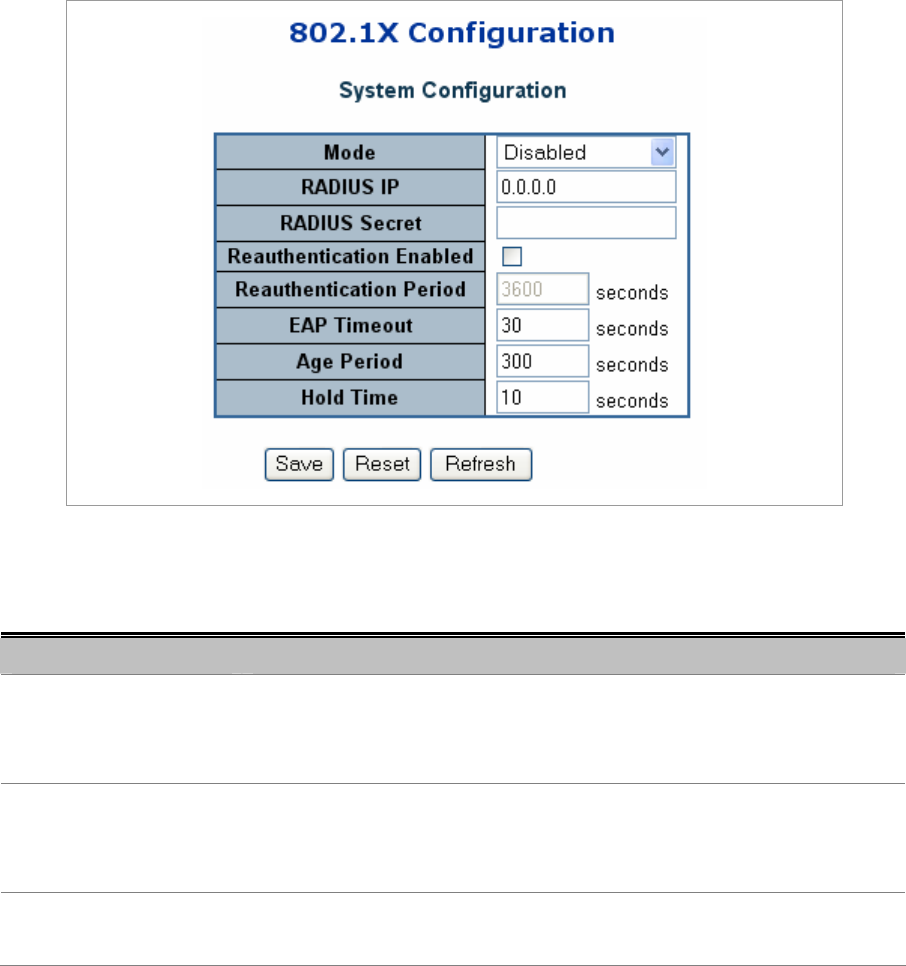Manual
Table Of Contents
- 1. INTRODUTION
- 2. INSTALLATION
- 3. SWITCH MANAGEMENT
- 4. WEB CONFIGURATION
- 4.1 Main WEB PAGE
- 4.2 System
- 4.3 Simple Network Management Protocol
- 4.4 Port Management
- 4.5 Link Aggregation
- 4.6 VLAN
- 4.7 Rapid Spanning Tree Protocol
- 4.8 Quality of Service
- 4.9 Multicast
- 4.10 IEEE 802.1X Network Access Control
- 4.10.1 Understanding IEEE 802.1X Port-Based Authentication
- 4.10.2 802.1X System Configuration
- 4.10.3 802.1X and MAC-Based Authentication Port Configuration
- 4.10.4 802.1X Port Status
- 4.10.5 802.1X and MAC-Based Authentication Statistics
- 4.10.6 Windows Platform RADIUS Server Configuration
- 4.10.7 802.1X Client Configuration
- 4.11 Access Control Lists
- 4.12 Address Table
- 4.13 Port Security (To be Continued)
- 4.14 LLDP
- 4.15 Network Diagnastics
- 4.16 Stacking – SGSW-24040 / SGSW-24040R
- 4.17 Power over Ethernet (SGSW-24040P / SGSW-24040P4)
- 5. COMMAND LINE INTERFACE
- 6. Command Line Mode
- 6.1 System Command
- 6.2 Port Management Command
- 6.3 Link Aggregation Command
- 6.4 VLAN Configuration Command
- 6.5 Spanning Tree Protocol Command
- 6.6 Multicast Configuration Command
- 6.7 Quality of Service Command
- 6.8 802.1x Port Access Control Command
- 6.9 Access Control List Command
- 6.10 MAC Address Table Command
- 6.11 LLDP Command
- 6.12 Stack Management Command
- 6.13 Power over Ethernet Command
- 7. SWITCH OPERATION
- 8. POWER OVER ETHERNET OVERVIEW
- 9. TROUBLE SHOOTING
- APPENDEX A
- APPENDEX B : GLOSSARY

User’s Manual of WGSW-24040 Series
SGSW-24040/24240 Series
147
4.10.2 802.1X System Configuration
This page allows you to configure the IEEE 802.1X and MAC-based authentication system and port settings.
The IEEE 802.1X standard defines a port-based access control procedure that prevents unauthorized access to a network by
requiring users to first submit credentials for authentication. A central server, the RADIUS server, determines whether the user is
allowed access to the network.
MAC-based authentication allows for authentication of more than one user on the same port, and doesn't require the user to
have special 802.1X software installed on his system. The Managed Switch uses the user's MAC address to authenticate
against the RADIUS server. Intruders can create counterfeit MAC addresses, which makes MAC-based authentication less
secure than 802.1X authentication.
The 802.1X System Configuration screen in Figure 4-10-3 appears.
Figure 4-10-3 802.1X Configuration page screenshot
The page includes the following fields:
Object Description
• Mode
Indicates if 802.1X and MAC-based authentication is globally enabled or disabled
on the switchstack. If globally disabled, all ports are allowed forwarding of
frames.
• RADIUS IP
The IP address of the RADIUS Server expressed in dotted decimal notation. If
the RADIUS IP changes while the protocol is globally enabled, then all
ports/clients will get reinitialized.
• RADIUS Secret
The secret - up to 29 characters long - shared between the RADIUS Server and
the switchstack.










